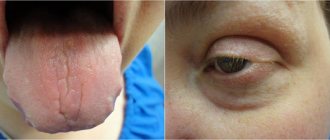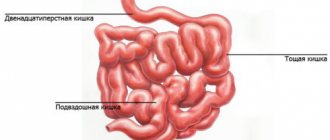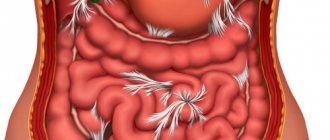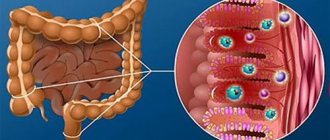Fibromyalgia is a syndrome of chronic musculoskeletal pain (more than 3 months) of a diffuse nature of a non-inflammatory nature, which most often has a symmetrical nature. The name of the pathology comes from the Latin words fibro - fiber, myo - muscle and algos - pain.
Patients who have fibromyalgia syndrome suffer from constant symmetrical pain throughout the body, suffer from depressive disorders (as a consequence of fibromyalgia), sleep poorly, often complain of irritable bowel syndrome, chronic fatigue syndrome, suffer from muscle stiffness, and have an increased pain threshold sensitivity - and this is only part of the disorders that accompany this disease.
Today, fibromyalgia as a disease is not recognized by all specialists, since the cause of this painful condition is unknown, and when examining patients, no significant deviations from the norm are found. Nevertheless, the problem exists and ruins the lives of hundreds of thousands of people.
According to modern statistics, this diagnosis ranks 3rd among the reasons why patients turn to a rheumatologist. The prevalence of fibromyalgia in the population is 6-8%, and in approximately 30% of people it causes permanent disability. Women are more often affected and account for approximately 70-80% of all cases. The debut of the pathology most often occurs at the age of 35-40 years, although fibromyalgia is often diagnosed in the elderly and children. Fibromyalgia was first identified as a separate clinical syndrome in 1904.
Description of the disease
A special feature of fibromyalgia is its many possible manifestations.
In addition to pain, very often there is a combination of the syndrome with a depressive state, as well as increased anxiety and other mental disorders. This is a common but not required sign. So what is fibromyalgia? In general terms, we can say that fibromyalgia is a complex of symptoms, the main of which is chronic musculoskeletal pain and the presence of painful points located in a certain way. In addition, other symptoms may be present (sleep disturbances, fatigue, numbness, etc.), which is why the pathology is often called fibromyalgia syndrome.
What is fibromyalgia
Fibromyalgia syndrome is a rheumatological extra-articular pathology, the main symptom of which is pain throughout the body. The disease is characterized by increased fatigue of skeletal muscles and pain in certain points on the body. According to the main medical theory, the nature of the disease is associated with overexcitation of spinal cord neurons. Disruption of the pain perception mechanism in fibromyalgia is not accompanied by inflammation of peripheral tissues.
The main role in the development of the disease is played by disruption of the process of perception of the pain impulse against the background of neurodynamic disorders in the CNS (central nervous system). The exact causes of fibromyalgia have not yet been established. Risk groups include people aged 25 to 40-50 years, female, especially during menopause, with a history of the following factors:
- hereditary predisposition;
- increased psycho-emotional stress;
- some specific infections (HIV, tick-borne borreliosis, herpes type 6, Epstein-Barr virus);
- consequences of long-term therapy with drugs of certain pharmacological groups;
- hypothyroidism (thyroid dysfunction), hormonal disorders;
- severe injuries of the musculoskeletal system.
Causes of the disease
The causes of fibromyalgia are currently unknown.
Previously, the disease was classified as inflammatory or psychiatric. However, both assumptions turned out to be incorrect. The studies carried out have proven their complete inconsistency.
A hypothesis has been put forward about the role of sleep disturbances in the development of the disease. This relationship could not be confirmed. However, research conducted in Norway showed that women 45 years of age and older who suffer from insomnia are 5 times more likely to develop fibromyalgia than their peers with normal sleep.
A gender difference has been proven - the disease is diagnosed in women 10 times more often than in men. Moreover, with age, the risk of getting sick increases.
An increased risk of pathology with an established genetic predisposition has been confirmed. If close blood relatives have a history of fibromyalgia, the patient is 8 times more likely to develop it.
Diagnosis and treatment of fibromyalgia
Fibromyalgia is a complex disorder with widespread musculoskeletal pain, depression, sleep disturbances, morning stiffness, and fatigue. The disease is also characterized by the presence of painful areas on the body - so-called “pain points”. Women are more susceptible to developing this disease than men. Among all forms of chronic pain syndromes, fibromyalgia is the leader in terms of the prevalence of depression, the degree of maladaptation of patients suffering from this disease, i.e., the degree of reduction in their quality of life. Fibromyalgia is a disease that comes to the attention of not only rheumatologists, neurologists, pain specialists, but also general practitioners. According to statistics, fibromyalgia affects 2–4% of the population. However, despite its prevalence, the diagnosis of fibromyalgia in the world, particularly in Russia, is extremely rare. This is due to unusual manifestations of the disease, insufficient awareness of doctors and the lack of clear diagnostic criteria.
Story
Although the term “fibromyalgia” was coined relatively recently, this condition has long been described in the scientific literature. In 1904, William Gowers coined the term fibrositis. In the second half of the twentieth century, some doctors believed that fibrositis was a typical cause of muscle pain, others believed that fibrositis was a consequence of “stress” or “psychogenic rheumatism,” and the rheumatology community did not consider this pathology at all. The modern concept of fibromyalgia was created by Smythe and Moldofsky in the mid-1970s. They coined a new term, fibromyalgia. The authors identified the presence of local hypersensitivity, so-called “tender points,” as a characteristic symptom of fibromyalgia. They also found that patients with fibromyalgia often experience sleep disturbances. The next stage in fibromyalgia research was the development of the American College of Rheumatology (ACR) diagnostic criteria for fibromyalgia, which were published in 1990 [3]. Significant progress in the study of fibromyalgia has been made after researchers concluded that the condition is not caused by damage or inflammation of peripheral tissues. Therefore, all efforts were aimed at studying the central mechanisms of pathogenesis.
Etiology and pathogenesis
One of the most important mechanisms for the formation of chronic pain in fibromyalgia is the phenomenon of central sensitization (CS). It is characterized by the fact that after prolonged peripheral nociceptive stimulation, a certain level of excitation remains in the central sensory neurons of the dorsal horn, which maintains pain even in the absence of further peripheral pathology. However, numerous studies have demonstrated that CS can develop in the presence of disorders in the central nervous system without peripheral damage. Fibromyalgia is such an example. That pain can be the result of changes in the central nervous system and a “real” neurobiological phenomenon that contributes to the formation of pain seems unlikely to many. Often, patients with fibromyalgia who do not show peripheral changes are considered by doctors as malingerers or patients with hysteria. Some doctors, in situations where they cannot find an organic cause of pain, prefer to use diagnostic labels such as psychosomatic and somatoform disorders.
However, today it has been convincingly shown that CS, as well as a violation of the descending (noradrenergic and serotonergic) inhibitory control of pain, arise in fibromyalgia not as a result of peripheral changes in muscles, fascia, ligaments or connective tissue, but as a result of neurodynamic disturbances in the central nervous system in individuals with a genetic predisposition to this disease. exposure to a large number of stressful (physical and mental) events (Table 1).
Research into fibromyalgia over the past two decades has shown that the pain threshold varies with the degree of distress. Many psychological factors, such as hypervigilance, suspiciousness, catastrophizing, and external locus of pain control, may play an important role in the severity of fibromyalgia symptoms. Special studies have shown that patients with fibromyalgia have reduced serotonergic and noradrenergic activity. It was also found that patients with fibromyalgia have decreased levels of serum serotonin and its precursor L-tryptophan and a decrease in the main metabolite of serotonin in the cerebrospinal fluid, 5-hydroxyindole acetate. This evidence is supported by the fact that drugs that simultaneously increase serotonin and norepinephrine levels (tricyclic antidepressants, duloxetine, milnacipram and tramadol) are effective in treating fibromyalgia. Neurobiological evidence that fibromyalgia is a condition with increased pain sensitivity (PS) and impaired perception processes is confirmed by the results of hardware diagnostic methods: single-photon emission computed tomography and functional magnetic resonance imaging [1, 2].
Clinical picture and diagnosis
In 1990, the American College of Rheumatology developed guidelines for the diagnosis of fibromyalgia (ACR criteria) (Table 2) [3]. Although these criteria are not intended for use in clinical settings, but only in research settings, they are nevertheless more than 85% accurate in differentiating patients with fibromyalgia from similar conditions.
The main symptom of fibromyalgia is chronic diffuse pain, not caused by any pathology of the musculoskeletal system, which bothers the patient for at least three months. The pain is diffuse, spreading throughout the body above and below the waist. Typically, patients describe their condition as “I feel like I have pain everywhere” or “I always feel like I have a cold.” Patients usually describe pain that spreads throughout the muscles, but sometimes also report pain and swelling in the joints. In addition, patients often complain of paresthesia, numbness, tingling, burning, and a crawling sensation on the skin, especially in the legs and arms.
In patients with fibromyalgia, physical examination reveals only increased sensitivity or tenderness in certain points of the body. Examining painful spots requires experience. The doctor must know exactly where to palpate and with what force. According to the ACR criteria, 9 pairs of painful points for fibromyalgia have been identified (Fig.).
The pressure applied at these points should be 4 kg/cm, the pressure at which the examiner's nail beds turn white. When palpating 18 painful points, it is recommended to apply even pressure on paired points and, with the same force, palpate other areas of the body to compare sensitivity. Patients with fibromyalgia experience increased sensitivity in tender spots compared to other areas of the body. Painful points reflect areas of increased sensitivity to painful stimuli, and are not a consequence of local inflammation or tissue damage.
The presence of a positive reaction in more than 11 of 18 painful points was determined by the diagnostic criterion based on the analysis of statistical data from large populations of patients. However, not all patients with fibromyalgia will have increased sensitivity in more than 11 points. Once again, we note that the ACR criteria for fibromyalgia are intended for research purposes and not for making diagnoses for specific patients. However, examination of tender points is considered an important part of studying the functioning of the musculoskeletal system in patients with generalized pain syndrome. Palpation of soft tissues and joints allows you to identify areas of increased sensitivity. This examination allows you to exclude synovitis or myositis and is very important in the diagnosis of fibromyalgia.
As the ACR criteria show, fibromyalgia is not just a pain syndrome. This condition includes a whole range of symptoms that bother the patient. Along with chronic diffuse pain, another typical symptom of fibromyalgia is fatigue. This symptom is most pronounced upon awakening, but also occurs in the afternoon. Minor physical activity can dramatically increase pain and fatigue, although prolonged rest and inactivity can also aggravate symptoms.
Patients with fibromyalgia feel stiff in the morning and feel sleepy, even if they have slept for 8–10 hours. Such patients usually sleep lightly, often wake up and have difficulty falling asleep. Patients usually say: “No matter how long I slept, I feel like I was run over by a truck.”
Behavioral and psychological factors play a role in the development of the clinical picture of fibromyalgia. It has been established that the prevalence of psychiatric comorbidities in patients with fibromyalgia can reach from 30% to 60%, and the frequency of mental disorders is even higher. Depression and anxiety disorders are the most common conditions. In addition, most patients experience cognitive impairment. For example, patients typically describe their problems with concentration or attention as “brain fog.”
Recently, the FiRST (Fibromyalgia Rapid Screening Tool) questionnaire has been proposed to screen for fibromyalgia (Table 3). The advantages of the questionnaire are its brevity and ease of completion. It should be emphasized its high sensitivity (90.5%) and specificity (85.7%). It is important to note that the questionnaire is intended for screening and a diagnosis cannot be made using it alone. Patients who score 5 or more on the FiRST questionnaire should be carefully evaluated to make a definitive diagnosis of fibromyalgia.
Fibromyalgia Treatment
Non-drug treatment
A specially conducted analysis of various non-drug methods of treating fibromyalgia showed that two methods have significant effectiveness - cognitive behavioral therapy and physical education (Table 4) [4]. Both treatment methods showed sustained improvement in fibromyalgia symptoms for one year or more.
Drug treatment
Antidepressants
Among the medications, tricyclic antidepressants (TCAs) were among the first to be used to treat pain in fibromyalgia. Amitriptyline has been shown to be able to relieve pain, promote sleep, and reduce fatigue in patients with fibromyalgia [5]. At the same time, antidepressants from the group of selective serotonin reuptake inhibitors (SSRIs) (fluoxetine, sertraline, citalopram, paroxetine) showed low effectiveness in randomized, placebo-controlled trials for fibromyalgia [5].
Serotonin norepinephrine reuptake inhibitors (SNRIs) (venlafaxine, duloxetine, milnacipran) have been shown to be more effective than SSRIs. These drugs, like TCAs, inhibit the reuptake of serotonin and norepinephrine, however, unlike TCAs, they have virtually no effect on other receptors. This selectivity leads to fewer side effects and better tolerability. Data on venlafaxine indicate its successful use in the treatment of neuropathic pain and fibromyalgia [6].
In studies using duloxetine, there was a greater reduction in total Fibromyalgia Impact Questionnaire (FIQ) scores [7] and a 30% reduction in pain in 54% of those taking the drug compared with 33% of those taking placebo [8, 9]. Duloxetine is approved by the US Food and Drug Administration (FDA) as an SNRI for the treatment of major depressive disorder, neuropathic pain in diabetes mellitus and fibromyalgia.
Milnacipran, which is widely used as an antidepressant, is approved by the FDA for the treatment of fibromyalgia. In a 12-week randomized clinical trial (RCT), 125 patients with fibromyalgia received either milnacipran once or twice daily (at doses up to 200 mg/day) or placebo [10]. In total, 37% of patients with fibromyalgia achieved a 50% reduction in pain with a double dose, 22% with a single dose, and 14% with a placebo. In a 27-week study of milnacipran in 888 patients with fibromyalgia, 56% of patients experienced at least a 30% reduction in pain intensity, compared with 40% of those in the placebo group [11]. Side effects were generally mild and the most common symptoms were nausea and headache.
Despite the fact that many chronic pain syndromes, including fibromyalgia, are accompanied by depression, some studies have shown that the analgesic activity of antidepressants does not depend on their effect on the emotional status of patients [7–11].
A recent meta-analysis of 18 RCTs confirmed that antidepressants can reduce pain in fibromyalgia, reduce depression, fatigue, restore sleep and improve quality of life [5].
Anticonvulsants
Pregabalin
Pregabalin, an alpha-2-delta calcium channel ligand, is approved for the treatment of neuropathic pain and was the first drug approved by the FDA for the treatment of fibromyalgia.
Pregabalin (Lyrica) is the first and so far the only drug in Russia officially registered for the treatment of fibromyalgia. Pregabalin binds to the alpha-2-delta region of voltage-gated calcium channels in the central nervous system. Due to a decrease in the influx of calcium into neurons, the release of substance P, glutamate and norepinephrine is reduced, providing the analgesic and anxiolytic effect of pregabalin. The activity of this drug is limited to neurons and does not affect vascular calcium channels.
In a large RCT of 528 patients with fibromyalgia, pregabalin was shown to significantly reduce pain scores, improve sleep quality, reduce fatigue, and improve general well-being [12]. Study participants received placebo or one dose of pregabalin (150, 300, or 450 mg/day) for 8 weeks. All patients taking the drug showed improvement within 2 weeks, which persisted until the end of the study. A follow-up 6-month placebo-controlled study included 566 patients with fibromyalgia who completed a 6-week open-label study and responded to treatment (responders) [13]. Monotherapy with pregabalin 300, 450 or 600 mg/day (twice daily) was administered. The results show that the response to pregabalin treatment is prolonged over time. The time to decline in therapeutic response was significantly shorter in those receiving placebo than in those receiving pregabalin. Pregabalin with long-term therapy led to a later deterioration in parameters such as sleep disturbance, fatigue and general well-being of the patient. Two other large RCTs, where treatment lasted 13–14 weeks, showed that pregabalin monotherapy was effective in reducing pain in fibromyalgia at dosages of 300, 450, and 600 mg/day [14, 15]. The effectiveness of pregabalin in the treatment of fibromyalgia was assessed in a meta-analysis of six RCTs involving more than 2000 patients with fibromyalgia [16, 17]. Pregabalin was shown to reduce pain in fibromyalgia, improve sleep and improve quality of life, but did not affect the severity of depressive mood. In addition, patients with fibromyalgia treated with pregabalin experienced improvements in fatigue and anxiety.
Gabapentin
Gabapentin, whose pharmacological properties are similar to pregabalin, was used in a 12-week RCT of 150 patients with fibromyalgia [18]. There was a significant decrease in the mean pain intensity score in the gabapentin group than in the placebo group. In addition, gabapentin significantly improved scores on the fibromyalgia severity scale FIQ, the Patient Global Impression of Change (PGIC) scale, and the sleep quality scale. Compared with placebo, gabapentin resulted in a significant increase in the incidence of sedation, lightheadedness, and dizziness.
Tramadol
Tramadol is a centrally acting analgesic that binds to mu-opioid receptors and inhibits the reuptake of norepinephrine and serotonin. The combination of paracetamol (Acetaminophen) with tramadol in a ratio of 8:1 has shown synergy between both drugs in preclinical pain models. In a 13-week multicenter RCT, tramadol/paracetamol 37.5 mg/325 mg relieved fibromyalgia pain more effectively than placebo [21]. All adverse events recorded in this study (transient and non-serious adverse events) were well-known complications of tramadol: dizziness (vertigo), nausea, vomiting, constipation, drowsiness, headache and weakness.
Benzodiazepines
The effectiveness of benzodiazepines in the treatment of fibromyalgia has not been fully studied. Many studies have produced conflicting results. For example, benzodiazepines, including alprazolam (0.5–3.0 mg at bedtime), did not show superiority over placebo for the treatment of pain in fibromyalgia, but clonazepam was quite effective in relieving temporomandibular joint pain, which is often observed in fibromyalgia [22, 23]. In addition, this drug was quite effective in stopping restless legs syndrome, which is a common cause of restless and interrupted sleep in patients with fibromyalgia.
Local anesthetics
Systemic administration of lidocaine has been used to treat patients with fibromyalgia: single and course infusions of lidocaine in doses of 5–7 mg/kg led to a fairly noticeable reduction in pain in patients with fibromyalgia [24]. In a recent RCT of patients with fibromyalgia, lidocaine 50 mg was injected into a painful point in the trapezius muscle. As a result, not only a local reduction in pain at the injection site was observed, but also a general analgesic effect [25]. This study demonstrated the important role of peripheral tissues in the development of hyperalgesia in fibromyalgia and demonstrated the clinical utility of local anesthetic injections for the management of pain in fibromyalgia.
Conclusion
Thus, today there are four main directions in the treatment of fibromyalgia (Table 5): 1) reduction of peripheral pain, in particular muscle pain; 2) prevention of central sensitization; 3) normalization of sleep disorders; 4) treatment of concomitant pathology, in particular depression. The first approach is more aimed at relieving the acute pain of fibromyalgia and includes the use of physical therapy, muscle relaxants, muscle injections and analgesics. Central sensitization is successfully treated with cognitive behavioral therapy, sleep correction, antidepressants and anticonvulsants. Sleep disturbances are corrected by reducing stress exposure, aerobic exercise and gamma-aminobutyric acid (GABA) agonists. Drug and behavioral therapy for secondary pain affect (anxiety, depression, fear) are among the most promising treatment strategies for fibromyalgia. Although any combination of these approaches can be very beneficial for patients with fibromyalgia, only comparative studies can provide reliable data on the effectiveness of a particular treatment method. All experts emphasize the need for a comprehensive multimodal approach in the treatment of fibromyalgia, including both pharmacological and non-drug methods.
Literature
- Mease P. Fibromyalgia syndrome: review of clinical presentation, pathogenesis, outcome measures, and treatment // J Rheumatol. 2005; 32, suppl. 75:6–21.
- Smythe HA, Moldofsky H. Two contributions to understanding of the “fibrositis” syndrome // Bull Rheum Dis. 1977; 28:928–931.
- Wolfe F, Smythe HA, Yunus MB et al. The American College of Rheumatology 1990 criteria for the classification of fibromyalgia: report of the Multicenter Criteria Committee // Arthritis Rheum. 1990; 33 (2): 160–172.
- Jones KD, Adams D, Winters-Stone K et al. A comprehensive review of 46 exercise treatment studies in fibromyalgia (1988–2005) // Health Qual Life Outcomes. 2006; 4: 67–73.
- Hauser W., Bernardy K., Uceyler N. et al. Treatment of fibromyalgia syndrome with antidepressants: a metaanalysis // JAMA. 2009; 301(2):198–209.
- Zijlstra TR, Barendregt PJ, van de Laar MA Venlafaxine in fibromyalgia: results of a randomized, placebocontrolled, double-blind trial [abstract] // Arthritis Rheum. 2002; 46:S105.
- Bennett R. The Fibromyalgia Impact Questionnaire (FIQ): a review of its development, current version, operating characteristics and uses // Clin Exp Rheumatol. 2005; 23 (5): S. 154-16-21
- Arnold LM, Rosen A, Pritchett YL et al. A randomized, double-blind, placebo-controlled trial of duloxetine in the treatment of women with fibromyalgia with or without major depressive disorder // Pain. 2005; 119(1–3):5–15.
- Choy EHS, Mease PJ, Kajdasz DK et al. Safety and tolerability of duloxetine in the treatment of patients with fibromyalgia: pooled analysis of data from five clinical trials // Clin Rheumatol. 2009; 28(9):1035–1044.
- Vitton O., Gendreau M., Gendreau J. et al. A double-blind placebo-controlled trial of milnacipran in the treatment of fibromyalgia // Hum Psychopharmacol. 2004; 19 Suppl. 1:S27–35.
- Mease PJ, ClauwD. J., Gendreau RM et al. The efficacy and safety of milnacipran for the treatment of fibromyalgia: a randomized, double-blind, placebo-controlled trial // J Rheumatol. 2009; 36(2):398–409.
- Crofford LJ, Rowbotham MC, Mease PJ et al. Pregabalin for the treatment of fibromyalgia syndrome: results of a randomized, double-blind, placebo-controlled trial // Arthritis Rheum. 2005; 52(4):1264–1273.
- Crofford LJ, Mease PJ, Simpson SL et al. Fibromyalgia relapse evaluation and efficacy for durability of meaningful relief (FREEDOM): a 6-month, double-blind, placebo-controlled trial with pregabalin // Pain. 2008; 136:419–431.
- Arnold LM, Russell IJ, Diri EW et al. A 14-week, randomized, double-blinded, placebo-controlled monotherapy trial of pregabalin in patients with fibromyalgia // J Pain. 2008; 9: 792–805.
- Mease PJ, Russell IJ, Arnold LM et al. A randomized, double-blind, placebo-controlled, phase III trial of pregabalin in the treatment of patients with fibromyalgia // J Rheumatol. 2008; 35:502–514.
- Hauser W., Bernardy K., Uceyler N. et al. Treatment of fibromyalgia syndrome with gabapentin and pregabalin: a meta-analysis of randomized controlled trials // Pain. 2009; 145 (1–2): 69–81.
- Straube S., Derry S., Moore R., McQuay H. Pregabalin in fibromyalgia: meta-analysis of efficacy and safety from company clinical trial reports // Rheumatology. 2010; 49: 706–715.
- Arnold LM, Goldenberg DL, Stanford SB et al. Gabapentin in the treatment of fibromyalgia: a randomized, double-blind, placebo-controlled, multicenter trial // Arthritis Rheum. 2007; 56(4):1336–13443.
- Tofferi JK, Jackson JL, O'Malley PG Treatment of fibromyalgia with cyclobenzaprine: a meta-analysis // Arthritis Rheum. 2004; 51(1):9–13.
- Xaio Y., Michalek JE, Russell IJ Effects of tizanidine on cerebrospinal fluid substance P in patients with fibromyalgia. In: Saper JR, editor. Alpha-2 adrenergic experience: evidence and examined. Worcester, UK: The Royal Society of Medicine Press, The Trinity Press, 2002: 23–28.
- Bennett RM, Kamin M, Karim R et al. Tramadol and acetaminophen combination tablets in the treatment of fibromyalgia pain: a double-blind, randomized, placebocontrolled study // Am J Med. 2003; 114(7):537–545.
- Russell IJ, Fletcher EM, Michalek JE et al. Treatment of primary fibrositis/fibromyalgia syndrome with ibuprofen and alprazolam: a double-blind, placebo-controlled study // Arthritis Rheum. 1991; 34(5):552–556.
- Fishbain DA, Cutler RB, Rosomoff HL et al. Clonazepam open clinical treatment trial for myofascial syndrome associated chronic pain // Pain Med. 2000; 1 (4): 332–339.
- Bennett MI, Tai YM Intravenous lignocaine in the management of primary fibromyalgia syndrome // Int J Clin Pharmacol Res. 1995; 15 (3): 115–119.
- Staud R., Nagel S., Robinson ME et al. Enhanced central pain processing of fibromyalgia patients is maintained by muscle afferent input: a randomized, double-blind, placebo controlled trial // Pain. 2009; 145:96–104.
A. B. Danilov, Doctor of Medical Sciences, Professor
GBOU VPO First Moscow State Medical University named after. I. M. Sechenova Ministry of Health and Social Development of Russia, Moscow
Contact information about the author for correspondence
Buy an issue with this article in pdf
Symptoms
More than 50 symptoms have been described that may be associated with fibromyalgia syndrome. At the same time, there are no obvious damage to internal organs, inflammation and other clear signs of the pathological process. It is for this reason that diagnosis presents some difficulties. Often the diagnosis is made by exclusion.
Fibromyalgia syndrome presents with varying combinations of the following symptoms. Moreover, over time, their combination may change - some of the signs may disappear or transform into others. In addition, periods of remission of the disease are possible, when most of the symptoms disappear or appear much weaker.
Joint and muscle
The disease always affects the condition of the muscles, and the joints are affected only in some cases. The patient is concerned about:
- muscle cramps and twitching;
- stiffness of movement in the morning;
- swelling;
- lumps in the chest;
- pain in the jaw.
Sensory
The body's reaction to external stimuli sometimes intensifies and becomes inadequate. There may be increased sensitivity to the following environmental factors:
- smell;
- humidity;
- pressure;
- light;
- temperature;
- noise.
Cognitive
Very often, patients with fibromyalgia experience difficulty concentrating, absent-mindedness and confusion. Doctors call this phenomenon fibrous fog. Additionally there may be:
- difficulty in clearly pronouncing words;
- misunderstanding of text read or heard;
- disorientation in space;
- memory impairment;
- Difficulty learning new material.
Neurological
Neurological symptoms are characterized by their inconsistency. They may appear periodically and then disappear for a while. The most common patient complaints include:
- depressive states;
- irritability, tearfulness;
- problems with coordination of movements;
- migraine attacks, headaches;
- panic attacks;
- dizziness and fainting;
- mood swings;
- ringing or noise in the ears.
Digestive
The likelihood of gastrointestinal malfunction is especially high in patients who do not follow a diet. Disordered eating habits can lead to:
- frequent urge to urinate;
- nausea;
- pain in the pelvic area;
- bloating;
- difficulty swallowing.
Sleep disorders
Lack of adequate sleep worries 96% of patients with fibromyalgia syndrome. Polysomnographic studies conducted in 1957 revealed unusual fluctuations that are not typical for healthy individuals. Since then, the established phenomenon has been used as a distinctive feature of the disease.
Analysis of sleep disorders can reveal:
- superficial, light sleep;
- restless legs syndrome;
- insomnia;
- morning fatigue.
Reproductive
The influence of hormonal levels on the appearance and development of the disease has not been proven. However, there is a connection between fibromyalgia and disorders of the reproductive system. Possible complaints:
- premenstrual syndrome;
- painful menstruation;
- decreased libido;
- impotence;
- early menopause.
Cardiovascular
If pain occurs in the heart area, it is necessary to conduct an additional examination, since the relationship between fibromyalgia and cardiac failure has not been proven. That is, the development of cardiovascular pathology can occur regardless of the underlying disease. However, fibromyalgia syndrome can be associated with irregular heartbeats and pain that is very similar to a heart attack.
Atypical pain sensations
The pain syndrome in fibromyalgia has its own characteristic features that make it possible to distinguish the disease from similar conditions:
- movement of pain throughout the body;
- increased sensitivity to temperature or touch;
- severe pain syndrome;
- unusual unpleasant sensations in the hands - burning, tingling, lack of sensitivity, itching, etc.
General symptoms
This group includes signs that are difficult to classify, as well as those related to several systems at once:
- nosebleeds;
- allergic reactions;
- weather dependence;
- the appearance of benign tumors;
- abnormal reactions of the body, especially after great mental or physical stress;
- increased sweating;
- hair loss or ingrown hair;
- hereditary predisposition to the disease (diagnosed cases in blood relatives).
Symptoms of fibromyalgia
The development of the disease is usually slow and often invisible to humans. The first visit to a doctor regarding chronic pain occurs no sooner than 6-8 years from the onset of the pathology (it is at this moment that most victims realize that the pain will not go away on its own). Pain syndrome most often develops for no apparent reason, but sometimes the patient can clearly indicate a physical or emotional trauma after which the pain began.
Pain is present in 100% of patients. They are characterized as diffuse symmetrical musculoskeletal pain of a monotonous nature. The pain intensifies after physical and emotional stress, after hypothermia. Decreases and/or disappears after exposure to heat, massage, and rest. Throughout the day, the pain can change its intensity, but almost never goes away for a long time.
Chronic muscle pain occurs in all patients with fibromyalgia
Most often, pain occurs in the muscles of the neck, back, shoulder girdle, lower back, less often it is localized in the upper and lower extremities, on the front of the chest.
A specific diagnostic sign is the detection of painful points on the patient’s body. Their number varies significantly from person to person. As a rule, they are located symmetrically at the points of attachment of muscle and tendon fibers to the skeleton. When these points are palpated, the painful sensations intensify, but the pain does not radiate, which helps to distinguish fibromyalgia in adults and children from myofascial pain, in which the points are called trigger points and provoke the appearance of pain in other parts of the body.
Specific pain points in patients with fibromyalgia
You should also know about control points - they will also help make a differential diagnosis:
- middle part of the forehead;
- volar surface of the middle part of the forearm;
- anterior surface of the mid-thigh;
- nail on the first finger.
Palpation of these points in a patient with fibromyalgia will not be painful, but pain will occur at the control points if the pain is associated with psychosomatic disorders.
The second most important symptom is chronic fatigue, which affects 82% of patients with fibromyalgia. Complaints of sleep disturbances are also common. Such people's sleep is superficial, fragmented, they have difficulty falling asleep, and often wake up at night. The pattern that is often observed is that the patient feels more tired after sleep than before going to bed. Such a dream received the characteristic name “non-restorative”.
Insomnia is a problem for most fibromyalgia patients.
Approximately 70% of people with this disorder complain of a feeling of muscle stiffness and stiffness in the body when trying to perform movements. Such sensations intensify in the morning and evening hours. Also often troubling are cramps in the calf muscles, paresthesia (tingling, numbness, crawling sensation), a feeling of fullness in the arms and legs, and swelling.
An important feature of fibromyalgia is a disorder in the human mental sphere. Most often, depression, hypochondria, and constant anxiety are recorded in such patients.
In some patients, fibrotic nodules that are painful on palpation can be detected in the thickness of the muscles. According to their histological structure, they represent fibro-adipose tissue without any signs of inflammation. More than half of patients have migraine-like headaches.
Other common disorders associated with fibromyalgia include:
- weather dependence;
- tension headache;
- fluctuations in body temperature throughout the day;
- impaired ability to concentrate, inability to concentrate for a long time;
- mood swings;
- emotional lability;
- irritable bowel syndrome;
- dysmenorrhea in women;
- heart rhythm disturbance;
- pain syndrome of the temporomandibular joint;
- dizziness;
- Raynaud's syndrome;
- autonomic disorders – cold hands, increased sweating, dry mouth;
- sleep apnea syndrome.
Depression often occurs in association with chronic muscle pain
Diagnostic criteria
A long list of symptoms does not mean that all of them must necessarily bother the patient. Their combination can be arbitrary. Thus, the clinical picture of each patient is individual and unique. The doctor must take this into account when making a diagnosis.
In 1990, the American College of Rheumatology proposed specific diagnostic criteria to accurately define pathology. If they are present, the diagnosis can be considered confirmed. The necessary conditions:
- The main feature of the disease is pain. In fibromyalgia syndrome, it has some features. The pain should be:
- diffuse , i.e. observed in all four quadrants of the body - above/below the waist, left/right;
- skeletal - any part of the axial skeleton can hurt;
- chronic – pain does not stop for 3 or more months.
In the 1970s, 18 sensitive points were identified that, when pressed, a fibromyalgia patient feels pain. If 11 or more points are painful, the reaction can be considered positive.
Painful points in fibromyalgia
Additional criteria include sleep disorders and various functional disorders.
Diagnostics
First, let's find out which doctor to contact if you are concerned about the symptoms described above. The problem of diagnosing and treating fibromyalgia is dealt with by a rheumatologist, neurologist, therapist, and family doctor.
The diagnosis of fibromyalgia is made on the basis of complaints and examination data of the patient. The results of all laboratory and instrumental diagnostic methods are within normal limits, and they are prescribed to exclude other diseases that are clinically similar to fibromyalgia syndrome (for example, polymyositis, dermatomyositis, rheumatic or rheumatoid polymyalgia, systemic lupus erythematosus, rheumatoid arthritis, etc.) .
List of necessary studies for suspected fibromyalgia:
- general clinical blood and urine tests;
- biochemical examination of blood serum;
- determining the level of thyroid hormones to exclude hypothyroidism;
- rheumatic tests and markers of systemic connective tissue diseases;
- X-ray examination of joints and the spinal column to exclude arthritis, arthrosis, and osteochondrosis.
American Rheumatology Association Diagnostic Criteria for Fibromyalgia (1990):
- Diffuse musculoskeletal symmetric pain that has been bothering you for more than the last 3 months.
- The presence of pain on palpation of 11 out of 18 (9 pairs) pain points.
The diagnosis of fibromyalgia is reliable if the specified criteria are met and is possible if there is an insufficient number of pain points on the body.
For patients, special questionnaires have been drawn up, as in the photo, to indicate pain points on the body
Also, very recently, a special simplified questionnaire, FiRST (Fibromyalgia Rapid Screening Tool), was proposed, which is intended for screening fibromyalgia. Patient reviews confirm that it is much easier to use. The sensitivity of the questionnaire is 90.5% and the specificity is 85.7%.
It is important to understand that the questionnaire is intended only to screen for fibromyalgia and not to diagnose this pathology. If the patient scores 5 points or more, then he needs a more detailed examination to confirm the diagnosis.
It is necessary to carry out differential diagnosis, first of all, with the following diseases:
- chronic fatigue syndrome;
- depression;
- myofascial muscle pain;
- tension headaches and migraines;
- restless legs syndrome;
- Lyme borreliosis;
- drug and alcohol addiction;
- polymyalgia rheumatica;
- dermatomyositis;
- polymyositis;
- systemic lupus erythematosus;
- rheumatoid arthritis.
Treatment
Given the uncertainty of the causes of the disease and the multivariate nature of its course, it is difficult to clearly determine how to treat fibromyalgia. The therapeutic method must be selected individually, since each patient's symptoms will look different. In addition to the therapist, a rheumatologist and a neurologist are involved in the management of the patient. Treatment is carried out in several directions at once.
Medication
The prescription of medications is aimed at eliminating pain, irritability and insomnia, as well as easing muscle spasms, that is, symptomatic treatment. For this purpose the following are used:
- Antidepressants . They are first-line drugs. Due to increased levels of neurotransmitters in the brain, anxiety, tendency to depression and the intensity of symptoms are reduced. May cause drowsiness, dry mouth and other undesirable effects.
- Analgesics . Reduce pain and significantly improve the patient’s quality of life.
- Muscle relaxants . By influencing the central nervous system, they have a positive effect on the general condition of the patient, increase the quality of sleep, reduce fatigue and pain sensitivity. They have an impressive list of all kinds of side effects, among which the most common are dizziness and absent-mindedness.
- Anticonvulsants . They have moderate effectiveness in the treatment of fibromyalgia. Due to contraindications, they are not suitable for all patients.
Non-drug
Two non-drug treatment methods have proven effectiveness:
- Cognitive behavioral therapy . Psychotherapeutic sessions allow you to understand the influence of your own thoughts and behavior on your health. With the help of a specialist, in most cases it is possible to increase control over the negative symptoms that cause the most concern.
- Physiotherapy . It is especially effective at the initial stage of the disease. The most beneficial form of physical activity is swimming. With regular exercise for a year, improvement was noted in all patients. The only caveat is that you need to monitor the water temperature; exposure to low temperatures can further aggravate the symptoms.
In addition, physiotherapy, hypnosis and self-hypnosis, massage, hyperbaric oxygen therapy, spa treatment, cryotherapy and other methods are used.
Unconventional
Alternative medicine is widely used to treat fibromyalgia. Its effectiveness has been studied and confirmed by the European Association of Cardiology and Rheumatology. For patients with fibromyalgia, plants that have a general strengthening, cleansing and calming effect are useful. Particularly well proven:
- Leuzea (maral root) – improves blood composition, has a beneficial effect on the condition of the liver, enhances protein synthesis, strengthens the heart, stimulates muscle activity;
- Chinese Schisandra - has a tonic effect, effective in treating depression and apathy;
- ginseng – improves metabolism, normalizes sugar levels, and has general strengthening properties.
As additional remedies at home, you can use self-prepared formulations.
For external use:
- A mixture of sunflower oil and red pepper . Helps relieve muscle spasms. Prepare as follows: mix 4 tbsp. pepper and 100 ml oil. Moisten a bandage in the composition and apply to problem areas.
- Infusion of lilac and birch . 1 tbsp. birch buds and dry lilac leaves pour 50 ml of boiling water. Wipe the affected areas with a cloth soaked in the infusion.
- Massage with essential oils . For 1 drop of chamomile oil, add 5 drops of rosemary ether. Rub the resulting composition with massage movements.
Herbal teas:
- Dandelion root and burdock . 1 tbsp. each ingredient per 1 liter of boiling water. Take throughout the day. The composition cleanses the body.
- Tea with the addition of lemon balm, valerian, motherwort . Calms the nervous system. To achieve the effect, it is enough to drink 1 glass of the drink in the evening.
Non-traditional methods cannot replace qualified treatment. Therefore, the use of home remedies is permissible only after medical consultation.
You can learn more about treating fibromyalgia at home here - Fibromyalgia: symptoms and treatment at home.
Causes
Doctors still don't know why fibromyalgia syndrome occurs. The exact cause of the disease has not been identified, but there are some factors that provoke the pathology. As is known, the disease most often occurs in a chronic form due to stressful situations.
There are the following causes of fibromyalgia:
- Insomnia may be the main trigger. Fibromyalgia can make it difficult for sufferers to sleep and this can lead to extreme fatigue. Patients who have this pathology may experience severe pain.
- Genetic predisposition also influences the development of fibromyalgia.
- Stressful events such as injuries, viral diseases, surgical interventions.
- Osteoarthritis can lead to pathology, as joint damage occurs and severe pain occurs.
- Rheumatoid arthritis.
- Hormonal disbalance.
- Constant overwork.
The above problems are most often identified during examination. If fibromyalgia is detected, the specialist prescribes comprehensive drug treatment. This will help eliminate the cause of the disease and alleviate the patient’s condition. Most often, traditional medicine and special diets can be used.
Forecast
Fibromyalgia is a persistent condition. The course of the disease involves alternating periods of remission and exacerbations. If you maintain your usual lifestyle and lack of treatment, the prognosis is unfavorable - over the years the disease is guaranteed to progress and can lead to disability.
To reduce symptoms and alleviate the condition, it is necessary to actively fight the disease: consult with doctors, limit the influence of stressful situations, undergo courses of prescribed therapy, and have a positive attitude.
Don't give up after being diagnosed with fibromyalgia. Your doctor will tell you what it is and how to treat such a disease. Modern methods make it possible to achieve long-term and stable remission. The main thing in the fight against an illness is the correct intention of the patient. With an optimistic outlook on life, the chances of a favorable prognosis increase significantly.
Treatment methods
Treatment is carried out in different ways using medicinal and non-medicinal agents. Medicines have an analgesic effect and combat the patient’s insomnia. Treatment without drugs is one of the types of therapy that includes different types of exercises.
It is important to identify it at an early stage. In case of prolonged illness, this can lead to serious consequences. For people who suffer from rheumatoid arthritis, the development of fibromyalgia can lead to pain and sleep disturbances.
The program consists of the following exercises: aerobic, stretching. Some patients find it difficult to perform such exercises; they quickly get tired, feel pain, and stop doing exercises. An analysis of such treatment showed that aerobic exercise improves physical condition and reduces discomfort. The exercises must be done slowly. Water aerobics, cycling, swimming are useful for treating the disease. Some do yoga.
Thanks to the use of non-drug therapy, patients' sleep improves and pain stops. For effective therapy it is necessary to use medications.
Medicines for the treatment of fibromyositis:
- Antidepressants. Used for treatment for many years. These include amitriptyline, doxepin, and desipramine. Start with small doses. The main advantage of the products is improving sleep and blocking pain.
- Drugs that affect serotonin, neurotransmitters. These include: duloxetine, milnacipran, venlafaxine. Each of the drugs has a different effect, the doctor prescribes these drugs depending on the complexity.
- Painkillers. These include tramadol, pregabalin and others. These medications have a quick effect and eliminate discomfort. They should not be taken without a doctor's recommendation.
There are contraindications to the treatment; such exercises may be due to various factors. In advanced cases, exercises are not recommended. In many situations, if the patient has other diseases, the list of medications should be reviewed, and the doctor may stop taking some medications.
Therapy may include:
- acupuncture;
- massage;
- phytotherapy;
- phototherapy;
- dietary nutrition;
- electrotherapy.
Etiology
As a result of significant sex differences, FM is more common among mature women.
Sometimes the disease is detected in children and adolescents.
The disease affects completely healthy people for no reason.
The only confirmed cause is heredity.
According to statistics, if this pathology has already been diagnosed in the family, then it is 8 times more likely to be encountered in the heirs.
Of course, fibromyosis can also be caused by external factors: illness or lifestyle.
Factors causing the disease:
- damage, inflammation or dysmetabolic damage to nerves;
- herpes, borreliosis, mononucleosis, Q fever, other infectious diseases;
- a person evaluates the world negatively, has a negative attitude towards everything around him, is often suspicious or overly cautious;
- injuries, followed by severe pain, which causes prolonged stress;
- hormonal imbalance, hypothyroidism is considered the most dangerous;
- long-term use of medications, as a result of which the level of sensitivity of neurotransmitters decreases.
Most often it is not possible to identify the cause of the development of FM.
But if FM is detected, it is important to pay attention to special treatment in order to increase the effectiveness of general therapy and minimize risks.
Additional treatment
There are additional treatments available.
However, they are used strictly as prescribed by the doctor, since they may be incompatible with the characteristics of the body of a particular patient or with previously prescribed medications.
Additional methods include:
- Apitherapy is the use of bee venom, pollen, wax or royal jelly, which leads to the restoration of muscle tissue and the relief of symptoms;
- cryotherapy - liquid nitrogen allows you to cool the affected areas of the body, suppresses muscle spasms, stimulates blood circulation and gets rid of most symptoms;
- psychotherapy – allows you to have a positive outlook on life, get rid of negativity and reduce anxiety;
- acupuncture – improves mental state, and also reduces the number of areas on the body where pain is detected;
- massage – relieves stiffness that occurs with fibromyalgia in the morning, and also improves blood circulation in the muscles, which has a positive effect on well-being and quality of sleep;
- Exercise therapy – moderate physical activity reduces pain, suppresses many symptoms, and helps normalize the condition for a long period.
Hydrotherapy or hypnotherapy can also be used.
Doctors choose only one or two methods to complement the main treatment and not harm the patient.
Story
The actual source of fibromyalgia (FM) is currently unknown. The disease has several names - fibromyosis and fibromyositis (ICD code M79.7).
It was once believed that FM was caused by mental disorders or inflammatory processes in the body.
The definition of FM was given in the 70s. XX century, but the diagnostic algorithm was presented twenty years later.
It was possible to confirm that the disease is not associated with inflammation and rheumatic pathology at the beginning of the 21st century.
Thus, fibromyosis falls into the group of neurological diseases.
According to statistics, 4% of people on planet Earth have this pathology.
Fibromyosis manifests itself in severe pain symptoms, as a result of the body acquiring increased sensitivity of nerve tissue.
Namely, neurons located inside the dorsal horns of the spinal cord.
Painful symptoms are caused by various disease processes or as a result of herbs obtained against a background of unpleasant phenomena.
Accelerated development of fibromyalgia is caused by serotonergic and noradrenergic neurotransmitters.
This picture is confirmed by the result of a blood test, which shows low levels of serotonin, L-tryptophan and norepinephrine.
A lack of 5-hydroxyindole in the cerebrospinal fluid was also detected.
And she, in turn, is responsible for the production of the happiness hormone.
Thus, patients with FM are prone to depression and have a negative outlook on the world.
Basic treatment
Fibromyosis is a chronic disease. It should be understood that it is not possible to completely cure the disease. However, with proper therapy, the patient experiences a significant reduction in pain and also gets rid of secondary factors.
As a result, the person completely returns to his normal life. To treat FM, you should strictly follow your doctor’s recommendations. Treatment for fibromyalgia is usually complex and includes several medications.
The main drugs include:
- cholinomimetics (“Acetylcholine”) – stimulate the production of neurotransmitters, suppress the manifestation of the disease;
- anesthetics (“Lidocaine”) – analgesic effect, usually used on trigger points for palpation;
- analgesics (“Tramadol”) – relieve pain, help return to a full life, but can be seriously addictive;
- anticonvulsants (“Pregabalin”) – relieve the appearance of seizures, improve well-being, reduce discomfort in the muscles;
- antidepressants (“Amitriptyline”) – normalize the mental state and restore the quality of sleep.
Taking medications makes the treatment as effective as possible.
Sometimes non-steroidal anti-inflammatory drugs, hypnotics, muscle relaxants or sedatives are added to the main list.
They are prescribed to suppress specific symptoms and improve the general condition of the patient.
ethnoscience
Traditional medicine has not gained wide popularity.
However, it gives good results.
Its methods include compresses, tinctures, decoctions, baths and rubbing.
As a result, blood circulation in the muscles improves, the body’s immune abilities are restored, the emotional background is normalized and many symptoms are suppressed.
Recipes for folk remedies
Tincture of Chinese lemongrass.
- 10 g - crushed Chinese lemongrass fruits;
- 100 ml – boiling water;
- Leave until completely cooled, strain.
- Take – 2 times a day, 1 tsp.
Thyme tea.
- 2 tbsp. l. - dried thyme;
- 500 ml – boiling water;
- Infuse from evening until morning;
- Drink in the morning on an empty stomach / if pain occurs during the day / evening.
Essential oils.
- 10 drops – chamomile;
- 10 drops – rosemary;
- Mix.
- Rub with slow movements onto areas of the body with severe pain. Repeat daily.
Bath with thyme.
- 4 tbsp. l. - dried thyme;
- 500 ml – boiling water;
- Insist from evening until morning.
- Take a hot bath and add the tincture. Lie down for more than 30 minutes.
Vinegar compresses.
- Apple cider vinegar;
- Soft cloth/cotton pad;
- Moisten and apply to painful areas for 2 minutes.
Willow bark.
- 2 g - dried willow bark;
- 150 ml – boiling water;
- 5 minutes – cook.
- Drink 1 glass 2 times a day. The first dose should be in the morning on an empty stomach.
Ginger.
- 2 tsp. – ginger;
- 150 ml – water at room temperature;
- Stir and drink immediately 2 times a day.
Also useful will be tinctures of St. John's wort, calendula, horsetail and leuzea.
Take 2 times every day.
If there are no results or unpleasant symptoms appear,
you should stop taking it.
A popular additional remedy is to take homeopathic medicines.











